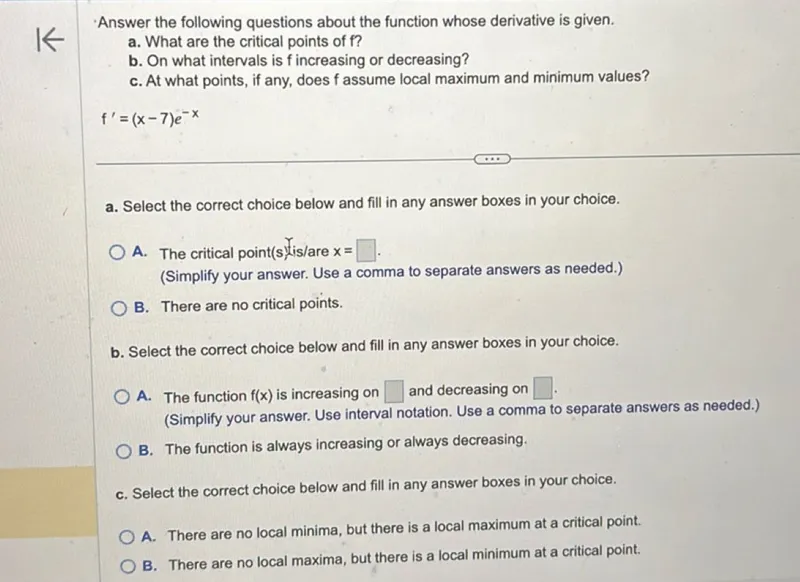Questions: Answer the following questions about the function whose derivative is given. a. What are the critical points of f ? b. On what intervals is f increasing or decreasing? c. At what points, if any, does f assume local maximum and minimum values? f'=(x-7)e^(-x) a. Select the correct choice below and fill in any answer boxes in your choice. A. The critical point(s) is/are x= . (Simplify your answer. Use a comma to separate answers as needed.) B. There are no critical points. b. Select the correct choice below and fill in any answer boxes in your choice. A. The function f(x) is increasing on and decreasing on . (Simplify your answer. Use interval notation. Use a comma to separate answers as needed.) B. The function is always increasing or always decreasing. c. Select the correct choice below and fill in any answer boxes in your choice. A. There are no local minima, but there is a local maximum at a critical point. B. There are no local maxima, but there is a local minimum at a critical point.

Transcript text: Answer the following questions about the function whose derivative is given.
a. What are the critical points of $f$ ?
b. On what intervals is $f$ increasing or decreasing?
c. At what points, if any, does $f$ assume local maximum and minimum values?
\[
f^{\prime}=(x-7) e^{-x}
\]
a. Select the correct choice below and fill in any answer boxes in your choice.
A. The critical point(s, is/are $x=$ $\square$ $\square$.
(Simplify your answer. Use a comma to separate answers as needed.)
B. There are no critical points.
b. Select the correct choice below and fill in any answer boxes in your choice.
A. The function $f(x)$ is increasing on $\square$ and decreasing on $\square$ . (Simplify your answer. Use interval notation. Use a comma to separate answers as needed.)
B. The function is always increasing or always decreasing.
c. Select the correct choice below and fill in any answer boxes in your choice.
A. There are no local minima, but there is a local maximum at a critical point.
B. There are no local maxima, but there is a local minimum at a critical point.





